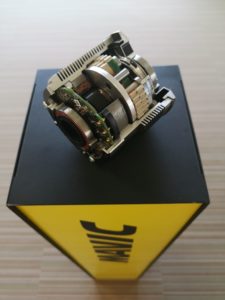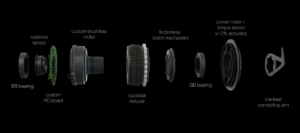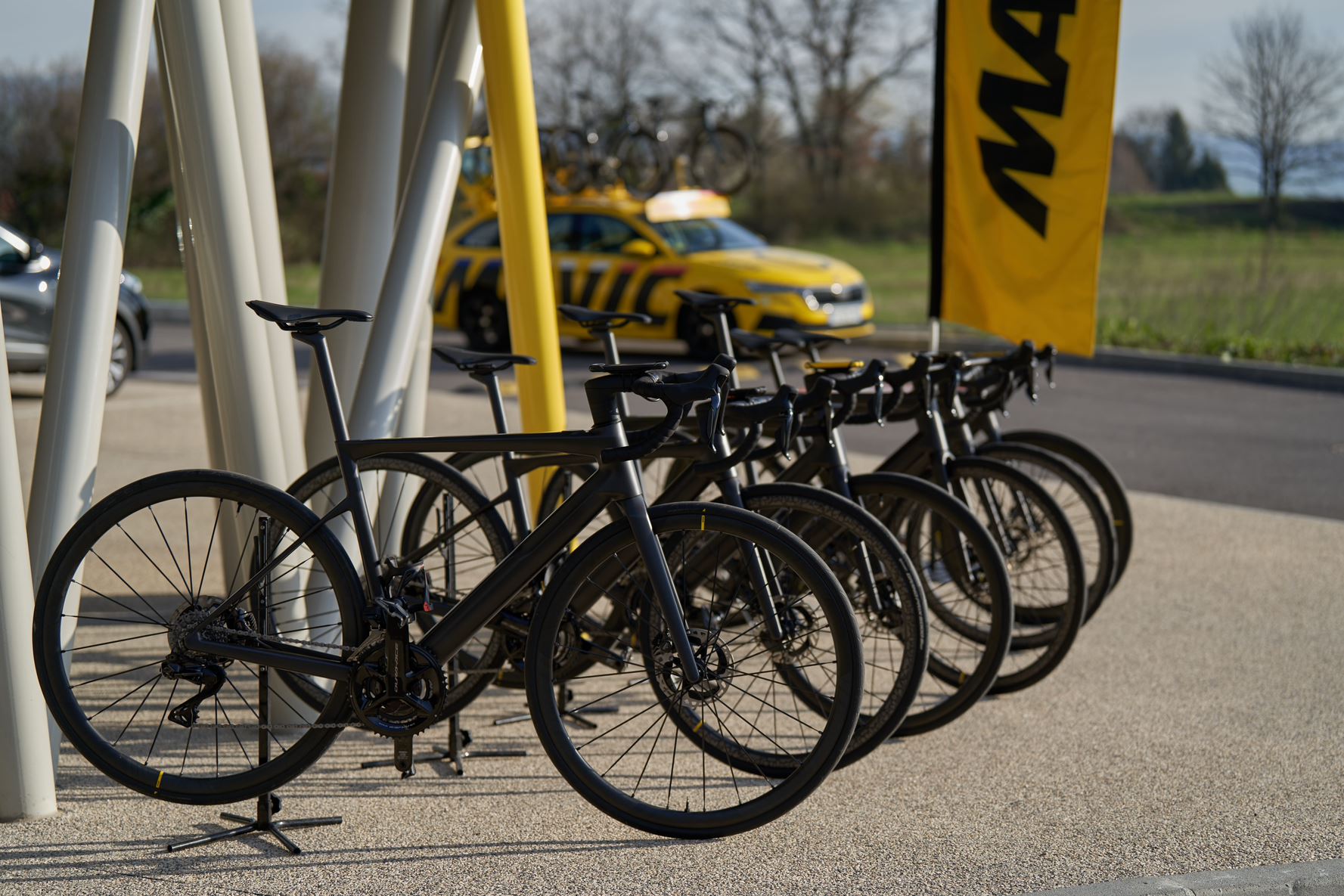The Mavic revolution is electric
In an industry currently grappling with rapid change, what it takes to raise eyebrows has certainly gone up a notch or 4. With this in mind, Mavic asked us to hold their Kronenbourg 1664 as they unveiled what few would have seen coming: An eBike motor called X-Tend.
X-Tend is, unlike any other eBike motor, developed around use of a regular, 24 mm spindle diameter, Shimano Hollowtech crankset, fully compatible with a front derailleur, utilizing power meter tech, and optimized around a standard road bike frame design*, with no impact on ride characteristic.
The raw stats:
- A sub 10 kg bike build using Ultegra Di2 (9.6kg with Dura Ace Di2)
- 3.2kg system weight, including a 360Wh battery and HMI control unit
- 250W normalized power up to 390W at peak power (37Nm with boost up to 50Nm)
Conventional eBike metrics don’t begin to do justice to the innovation that is Mavic X-Tend. Here we’re using them only to benchmark the package against the established industry players. ‘Why so?’ you ask. When you’re totally rewriting the rules, previous reference points serve only to quantify just how far you’ve moved the goal posts.
Headline project details:

- 5 years of product development
- 4 years and 120,000Km of road-based testing
- Motor units lab tested to 40,000km, to validate a 4 year warranty (double the EU mandated industry minimum standard)
- Swiss bike brand BMC as an innovation partner
How confident are Mavic that this multi million Euro investment will totally change the game? Confident enough to let a handful of journalists from across European B2B and B2C publications ride version 6.1, a production Verified Prototype.
‘You’re journalists’ I hear someone at the back shouting, ‘you only get access because you write neutral or positive reviews’. In reply I can tell you I’ve never deliberately ridden a bike with less mechanical sympathy. That I didn’t break the chain wasn’t because I wasn’t trying (sorry Mavic). Full power gear shifting – stamping on the pedals – combined with rapid changes of motor setting. Cadence dumps, from 90 to 50, and back to 90, whilst standing, both on the flat, and riding up what I’d guestimate was a 8% gradient. Low cadence gear and motor shifting (think ERG mode death spiral on a smart trainer). Over/under style intervals where you’re rolling on and off the power. All looking for the sensations you get when the motor responds to rapid changes in input (force on the pedals). And remember, the units we road are of a product still under development.
Of that assistance, X-Tend delivers in 3 levels: 30%, 60%, 120%, and an over boost of 150%, of leg power.
Another unique element of the X-Tend capability, and the beauty of using power meter technology (strain gauges), not torque sensors; the X-Tend responds to changes in rider generated pedal force, within each of the levels. I’d describe the sensation as a wave of additional torque which you most definitely can feel build progressively. The firmware development work required to achieve this smooth swell of responsive power is, I’d imagine, substantial. Experiencing this as a rider, it’s most definitely engineering and development time well spent.
 At this point it’s also worth mentioning that every part of the product is developed in the EU, with the motors built in France. That includes the app, which will deliver another industry first, displaying rider power and motor power at the same time, as separate metrics. Another benefit of using power meter tech.
At this point it’s also worth mentioning that every part of the product is developed in the EU, with the motors built in France. That includes the app, which will deliver another industry first, displaying rider power and motor power at the same time, as separate metrics. Another benefit of using power meter tech.
What’s it ride like?
In making the following observations it’s important to remembering that what Mavic invited us to ride is a pre-production version, with hardware and firmware still evolving. Testing units this way occasionally happens in the auto industry, with the most recent high-profile example, Henry Catchpole (sometime contributor at Cyclist magazine) driving a then still late-stage development Verification Prototype Lotus Emira, nearly a full year before customers took delivery of cars. The stipulation being that there remain elements which are not ‘final product / delivery to customer’ resolved, and this should be clearly communicated.
Caveat made, here are my observations:
I’ve certainly not experienced as natural a ‘motor off’ ride feel as that delivered by the X-Tend. Combine this with a standard 146mm Q-Factor and you have an eBike that rides just like a really good, non electric, performance road bike. The claim of ‘zero residual friction when the motor is off, or above 25Kph’ is a bold one, but hard to argue with, based on my ride experience in Annecy.
 Add this to that ultra slim 360Wh battery, good for 3000m of climbing we’re told, and you’ve an eBike that looks almost (HMI control unit aside) indistinguishable from the regular BMC Team Machine.
Add this to that ultra slim 360Wh battery, good for 3000m of climbing we’re told, and you’ve an eBike that looks almost (HMI control unit aside) indistinguishable from the regular BMC Team Machine.
When faced with big cadence jumps – the 50 to 90 or 90 to 50 I described above – the X-Tend unit currently has what feels like a 2 second lull in power delivery. Practical example: When making that inner / outer shift on the front, which results in a 2 or 3 gear corrective shift on the back – here’s where I found the brief feeling that the motor assistance drops out, and then comes back online. In fairness, this is also the point at which, on a non-electric bike, you’d momentarily soft pedal so as not to mash the chain and or derailleurs when making your gear shift.
As an amusing side note, the split second pause in motor assistance also serves as reminder that you are mortal, and not possessed with TdF winning leg and lung power.
It also nicely highlights that the motor output feels impressive.
I’ve certainly not ridden a bike that claims (only) 37Nm and feels this powerful, possibly highlighting another big claim which Mavic makes for X-Tend, as the “lowest friction system, and lowest consumption, (with) 0 residual friction when (the) motor is off”. For context, the majority of eBikes typically suffering overall efficiency losses of between 21% and 23%. Maybe this is why a Mavic 37Nm output felt so strong?

What did I not like?
On full power the X-Tend is, in current development stage, a little shrill (high pitched) and a little louder than I would like when in the full power setting (120%).
Acoustic engineering being what it is, the team at Mavic highlight that the final unit will not share the same sound as those we rode. In fairness to Mavic, the unit is not dissimilar in sound to the Fazua motor, and it is also fair to mention that on a road bike there is much less background noise distracting from the motor sound, than on an MTB.
Benchmarking the competition, the new TQ motor has certainly won many fans for the low level of sound it produces, and, in a pre Mavic X-Tend world, its relative light weight, with that unit finding its way onto both road and MTB set ups.
Pause for thought
 Whilst the X-Tend does undeniably totally reinvent the eBike motor, it does require some subtle bike design adaption. *The 87mm external shell of the motor will require bike brands (we’re told a number have already added the Mavic product into their future production road map) to adapt the BB area. Critically, the adaption retains a closed BB design, enabling bike designers to maintain established weight to stiffness ratios, an integral part in defining ride characteristics.
Whilst the X-Tend does undeniably totally reinvent the eBike motor, it does require some subtle bike design adaption. *The 87mm external shell of the motor will require bike brands (we’re told a number have already added the Mavic product into their future production road map) to adapt the BB area. Critically, the adaption retains a closed BB design, enabling bike designers to maintain established weight to stiffness ratios, an integral part in defining ride characteristics.
The BMC Team Machine we rode was just like almost every other Grand Tour-focused, aero optimised, non eBike I’ve ridden; responsive to fast direction changes, and stiff under load, in and out of the saddle, where aero optimisation comes with some sacrifice to ride comfort. Ask any Tarmac SL 6 owner who bought an SL7. It’s the feedback almost everyone gives.
The thing which many are looking to eBikes for, is their ability to enable riding, and exploring, when work and life means riding time, training time, and speed of recovery, have all taken a back seat to a life of fitting bikes in around regular work and family commitments.
Fit the X-Tend to a BMC Road Machine, or any other endurance bike for that matter, and you’d have the ultimate endurance geometry ‘big day out’ ride (with optimal range extender battery, if required).
Purely for weight comparison, the previous generation 2020 Trek Domane SL 6, a comfort focused endurance geometry bike equipped with mechanical Ultegra, tipped the scales at 9.53kg for a 58ccm (with no motor or battery).
Genuine game changer?
Undeniably, yes. As a concept, and in execution, even at this Verification Prototype stage. Further refinements will only add to the wow factor, IMHO.
The major concern
Mavic are seeking an investment partner for the push to full production of the X-Tend. Will that come in time to beat the development curve? It would be criminal if Mavic missed their innovation window with the X-Tend.
Price, and time frame
The X-Tend will be priced to sit between Fazua and TQ motor offerings, available as OEM only. Mavic anticipate a 2025 / 2026 market entry, with the potential for that to happen in 2024 dependant on one critical factor – securing an investment partner for the push to full production.



